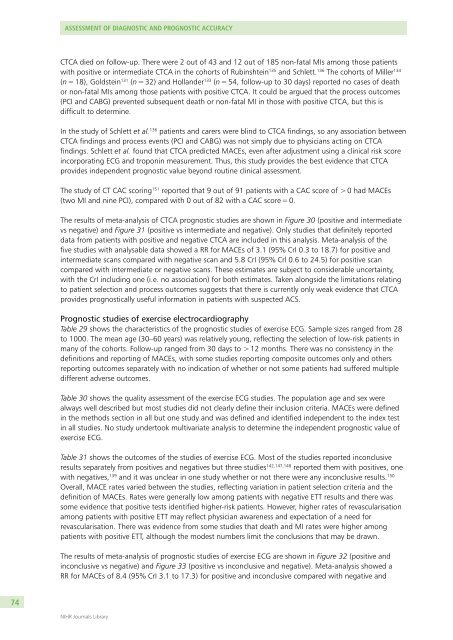Systematic review, meta-analysis and economic modelling of ...
Systematic review, meta-analysis and economic modelling of ...
Systematic review, meta-analysis and economic modelling of ...
You also want an ePaper? Increase the reach of your titles
YUMPU automatically turns print PDFs into web optimized ePapers that Google loves.
Assessment <strong>of</strong> diagnostic <strong>and</strong> prognostic accuracyCTCA died on follow-up. There were 2 out <strong>of</strong> 43 <strong>and</strong> 12 out <strong>of</strong> 185 non-fatal MIs among those patientswith positive or intermediate CTCA in the cohorts <strong>of</strong> Rubinshtein 135 <strong>and</strong> Schlett. 136 The cohorts <strong>of</strong> Miller 134(n = 18), Goldstein 131 (n = 32) <strong>and</strong> Holl<strong>and</strong>er 133 (n = 54, follow-up to 30 days) reported no cases <strong>of</strong> deathor non-fatal MIs among those patients with positive CTCA. It could be argued that the process outcomes(PCI <strong>and</strong> CABG) prevented subsequent death or non-fatal MI in those with positive CTCA, but this isdifficult to determine.In the study <strong>of</strong> Schlett et al. 136 patients <strong>and</strong> carers were blind to CTCA findings, so any association betweenCTCA findings <strong>and</strong> process events (PCI <strong>and</strong> CABG) was not simply due to physicians acting on CTCAfindings. Schlett et al. found that CTCA predicted MACEs, even after adjustment using a clinical risk scoreincorporating ECG <strong>and</strong> troponin measurement. Thus, this study provides the best evidence that CTCAprovides independent prognostic value beyond routine clinical assessment.The study <strong>of</strong> CT CAC scoring 151 reported that 9 out <strong>of</strong> 91 patients with a CAC score <strong>of</strong> > 0 had MACEs(two MI <strong>and</strong> nine PCI), compared with 0 out <strong>of</strong> 82 with a CAC score = 0.The results <strong>of</strong> <strong>meta</strong>-<strong>analysis</strong> <strong>of</strong> CTCA prognostic studies are shown in Figure 30 (positive <strong>and</strong> intermediatevs negative) <strong>and</strong> Figure 31 (positive vs intermediate <strong>and</strong> negative). Only studies that definitely reporteddata from patients with positive <strong>and</strong> negative CTCA are included in this <strong>analysis</strong>. Meta-<strong>analysis</strong> <strong>of</strong> thefive studies with analysable data showed a RR for MACEs <strong>of</strong> 3.1 (95% CrI 0.3 to 18.7) for positive <strong>and</strong>intermediate scans compared with negative scan <strong>and</strong> 5.8 CrI (95% Crl 0.6 to 24.5) for positive scancompared with intermediate or negative scans. These estimates are subject to considerable uncertainty,with the CrI including one (i.e. no association) for both estimates. Taken alongside the limitations relatingto patient selection <strong>and</strong> process outcomes suggests that there is currently only weak evidence that CTCAprovides prognostically useful information in patients with suspected ACS.Prognostic studies <strong>of</strong> exercise electrocardiographyTable 29 shows the characteristics <strong>of</strong> the prognostic studies <strong>of</strong> exercise ECG. Sample sizes ranged from 28to 1000. The mean age (30–60 years) was relatively young, reflecting the selection <strong>of</strong> low-risk patients inmany <strong>of</strong> the cohorts. Follow-up ranged from 30 days to > 12 months. There was no consistency in thedefinitions <strong>and</strong> reporting <strong>of</strong> MACEs, with some studies reporting composite outcomes only <strong>and</strong> othersreporting outcomes separately with no indication <strong>of</strong> whether or not some patients had suffered multipledifferent adverse outcomes.Table 30 shows the quality assessment <strong>of</strong> the exercise ECG studies. The population age <strong>and</strong> sex werealways well described but most studies did not clearly define their inclusion criteria. MACEs were definedin the methods section in all but one study <strong>and</strong> was defined <strong>and</strong> identified independent to the index testin all studies. No study undertook multivariate <strong>analysis</strong> to determine the independent prognostic value <strong>of</strong>exercise ECG.Table 31 shows the outcomes <strong>of</strong> the studies <strong>of</strong> exercise ECG. Most <strong>of</strong> the studies reported inconclusiveresults separately from positives <strong>and</strong> negatives but three studies 142,147,148 reported them with positives, onewith negatives, 139 <strong>and</strong> it was unclear in one study whether or not there were any inconclusive results. 150Overall, MACE rates varied between the studies, reflecting variation in patient selection criteria <strong>and</strong> thedefinition <strong>of</strong> MACEs. Rates were generally low among patients with negative ETT results <strong>and</strong> there wassome evidence that positive tests identified higher-risk patients. However, higher rates <strong>of</strong> revascularisationamong patients with positive ETT may reflect physician awareness <strong>and</strong> expectation <strong>of</strong> a need forrevascularisation. There was evidence from some studies that death <strong>and</strong> MI rates were higher amongpatients with positive ETT, although the modest numbers limit the conclusions that may be drawn.The results <strong>of</strong> <strong>meta</strong>-<strong>analysis</strong> <strong>of</strong> prognostic studies <strong>of</strong> exercise ECG are shown in Figure 32 (positive <strong>and</strong>inconclusive vs negative) <strong>and</strong> Figure 33 (positive vs inconclusive <strong>and</strong> negative). Meta-<strong>analysis</strong> showed aRR for MACEs <strong>of</strong> 8.4 (95% CrI 3.1 to 17.3) for positive <strong>and</strong> inconclusive compared with negative <strong>and</strong>74NIHR Journals Library
















